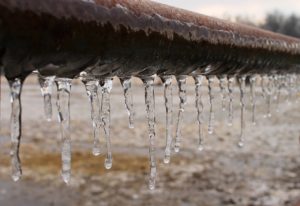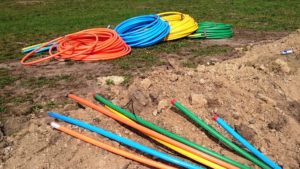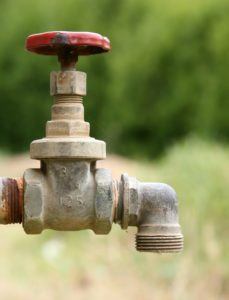October 5th, 2018 by
As temperatures start to drop, many people across Britain are looking ahead to the cold winter months. One of the most important things to prepare for in winter is the risk of frozen pipes. Luckily, temperatures will only drop low enough to freeze your pipes relatively rarely in this country, but it only needs to happen once for frozen pipes to cause some serious damage! When your water pipes freeze over, the water inside them expands, potentially causing thousands of pounds worth of damage to your home in the event of a serious leak. Luckily, there are plenty of ways you can prevent your pipes from freezing over in sub-zero temperatures, and we’ll run down a few of them below.
How to Identify Frozen Pipes
 Frozen pipes can happen in any part of the country. You might think they’re more common in areas where the temperatures drop lower – like the Scottish Highlands or the peaks – but other You’re also at risk of frozen pipes if you have any outdoor pipework – for example if your shed or garage has some plumbing. If any of this applies to you, you’ll need to be extra vigilant on freezing nights and watch for these telltale signs.
Frozen pipes can happen in any part of the country. You might think they’re more common in areas where the temperatures drop lower – like the Scottish Highlands or the peaks – but other You’re also at risk of frozen pipes if you have any outdoor pipework – for example if your shed or garage has some plumbing. If any of this applies to you, you’ll need to be extra vigilant on freezing nights and watch for these telltale signs.
Your Water Stops Running
Most people realise their pipes are frozen when their water stops running. The water might slow to a trickle or stop completely.
There’s a Weird Smell
If you notice strange smells coming from your taps or drains, it could be a sign there’s a frozen pipe somewhere. If your pipe is blocked up with ice, the bad smells from your pipe have nowhere else to go apart from back into your home.
Your Pipes are Frosty
If you can actually see your pipes, a quick check could reveal they're frosted over. For many homes, this isn’t possible, but if you have external pipework anywhere on your property it’s worth checking on a cold night.
How to Prevent Your Pipes from Freezing
An ounce of prevention is worth a pound of cure when it comes to frozen pipes! If you’re worried about your pipes freezing over in winter, try out the following steps before the temperature drops too low.
Lag Your Pipes
 If you have any pipes that are particularly at risk of freezing, you can lag them to help insulate them from the cold. Lagging is the name given to any material that insulates and protects water pipes from freezing. Usually, lagging materials are made of an insulating foam that you can fit over your pipes – it’s simple and you can easily do it yourself.
If you have any pipes that are particularly at risk of freezing, you can lag them to help insulate them from the cold. Lagging is the name given to any material that insulates and protects water pipes from freezing. Usually, lagging materials are made of an insulating foam that you can fit over your pipes – it’s simple and you can easily do it yourself.
Fix Any Drips
If you have a dripping tap or pipe, now is the time to get it fixed! Even the tiniest drips can lead to big problems down the line. Drips massively increase your risk of getting frozen pipes so get them fixed as soon possible. If you’re a landlord, encourage your tenants to report any drips immediately.
Leave Your Heating On
 When sub-zero temperatures are forecast, leave your heating on a low setting overnight or if you’re going on holiday. The only problem with this is that if your central heating is a few years old, chances are it’s not very efficient and this can be costly. Long-term, investing in cutting-edge heating technology like smart radiators is a great way to prevent frozen pipes. This MYLEK smart radiator, for example, features an app that lets you control your heating from anywhere in the world as long as you have an internet connection. This means you can turn your heating on and off at will even if you’re abroad, saving you from having to leave it on constantly. If you know your house is going to be empty for a little while when temperatures are low – for example, if you have tenants who are moving out - it’s worth turning off your stopcock and draining your pipes to make sure they don’t freeze over.
When sub-zero temperatures are forecast, leave your heating on a low setting overnight or if you’re going on holiday. The only problem with this is that if your central heating is a few years old, chances are it’s not very efficient and this can be costly. Long-term, investing in cutting-edge heating technology like smart radiators is a great way to prevent frozen pipes. This MYLEK smart radiator, for example, features an app that lets you control your heating from anywhere in the world as long as you have an internet connection. This means you can turn your heating on and off at will even if you’re abroad, saving you from having to leave it on constantly. If you know your house is going to be empty for a little while when temperatures are low – for example, if you have tenants who are moving out - it’s worth turning off your stopcock and draining your pipes to make sure they don’t freeze over.
What to Do if You Have Frozen Pipes
Sometimes, even in the UK, the temperature can drop so low that it’s hard to prevent frozen pipes. In the unlikely event that you follow all the above advice and still end up with frozen pipes, here’s what you can do.
Step 1: Turn Off Your Stopcock
 Turn off your stopcock immediately to prevent stop any more water from entering and potentially damaging your pipework. If you haven’t already, check to see if you can locate the site of your frozen pipe. Don’t try and run any water out of your pipes – you’ll most likely burst them if you do!
Turn off your stopcock immediately to prevent stop any more water from entering and potentially damaging your pipework. If you haven’t already, check to see if you can locate the site of your frozen pipe. Don’t try and run any water out of your pipes – you’ll most likely burst them if you do!
Step 2: Turn Up the Heat
Turn up your heating or use some electric panel heaters around your home to make things a little warmer. It might cost you a bit more on your heating bill, but it’ll still be cheaper than a burst pipe! You can also apply a gentle heat directly onto your frozen pipe to help thaw it. Use a hot water bottle, warm towel, or a hairdryer on a low setting to gently warm up your pipes.
Step 3: Call a Plumber
If your water doesn’t start running as normal once your pipes have thawed, then you may need to call a plumber. Even minor damage to pipes can cause big problems later on, so get the plumber on the phone as soon as possible.
Comments
Leave a reply
Your e-mail address will not be published. All fields are required


